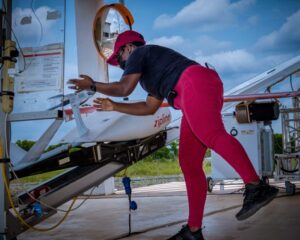…how Zipline’s medical drone deliveries are bridging the gap
Healthcare disparities have long been a pressing concern in remote communities like Oda. The limited infrastructure, scarcity of medical resources and skilled personnel pose significant obstacles to delivering healthcare services. For expectant mothers in these communities, the journey to safe and healthy childbirth can be perilous; fraught with uncertainty and danger.
At the Oda Government Hospital in the Birim Central municipality, Eastern Region, where I work as a general surgeon, I received a call telling me to head straight to the hospital to help with surgical intravenous access due to a post-partum haemorrhage. I started to worry immediately, because vital medical supplies, like blood, had run low the day before.
As a referral hospital for the local low-level health facilities, Oda Government Hospital provides a wide coverage area that is primarily rural. No matter the circumstances, we are always expected to be prepared to handle situations that are brought in for care. But considering the inherent limitations, I was on the edge contemplating how to provide this patient with the best care.
We decided to try Zipline, and we were pleasantly surprised. The Zipline drones delivered several units of blood with frozen plasma in only a few minutes – roughly 25 minutes. That marked the beginning of our love affair with Zipline.
From stock shortages to timely deliveries
Throughout the years, the service has assisted in providing many units of blood and blood products to complement the hospital blood bank’s low stock; emergency stocks of vaccines; laboratory reagents; and laboratory consumables. These have all been achieved in record time – reducing travel distances, travel risk and enhancing provision of timely service to patients.
Recent technological advancements have unlocked unimaginable possibilities for remote regions like Oda, and Zipline Ghana is at the forefront of this progress. Through their visionary drone logistics delivery service, they have transformed the healthcare landscape in our area; becoming the sevice that bridges the gap between life and death for countless patients in our community.
These drone deliveries have become a great complement to the existing means of supply for the regional stores, mostly during emergencies when we run out of stock. What was once a major concern when we ran out of medications has greatly been brought to a minimum concern, as we can rely on swift and efficient delivery of critical medical supplies, such as blood, vaccines and other life-saving medications.
Beyond this impressive speed, the innovative approach has significantly elevated the quality of care we provide. With the drones’ timely arrival, we can now focus on our patients’ well-being without compromising their treatment. Previously hindered by distance and logistical constraints, vaccination campaigns are now within reach. Children, adults and the elderly alike can benefit from timely immunisations, shielding them from preventable diseases and fostering a healthier, more resilient community. More importantly, we do not have to overstock these products, which may not even be used; we can order on-demand from Zipline and receive the same.

Enhancing Zipline’s Payload capacity for greater efficiency
Zipline’s support has been enormous, not only to our facility but also others benefitting from the same. Collaborating with them demonstrates a deep grasp of technology’s critical role in the country’s overall healthcare delivery.
However, Zipline should consider increasing the payload weight. The current 1.8kg seems smaller when we need several products at the same time. Also, the company could consider doing multiple trips at a given time, whereby for example a request could be delivered at point A and proceed to point B to drop the other.
The government of Ghana should be commended for such a bold move as partnering with Zipline at a time when not much had been heard about the company in our part of the world. Government, Zipline and all concerned citizens should focus on expanding this technology to other areas and ensuring its sustainability.
Continuous research for ongoing improvement
It would be interesting to read the findings of impact studies that should be conducted in the service areas to gauge the extent of uptake and impact. Novelty projects such as this greatly improve when there’s sufficient research on an ongoing basis to identify areas for improvement and establish the extent of Zipline’s impact on timely medical interventions, patient outcomes and overall healthcare accessibility, especially in remote areas.
Looking forward, I see healthcare improvements spreading to more rural areas – enabling fair access to excellent medical treatment for everyone and writing a new chapter in healthcare history when distance is no longer an impediment to life-saving treatment. It is my wish that this disruptive technology will continue to soar, impacting more lives and improving healthcare one drone flight at a time.










